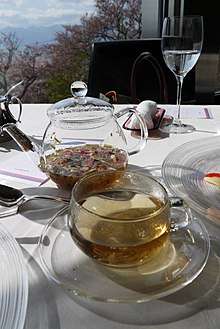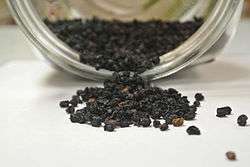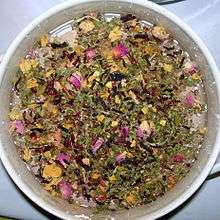Herbal tea
Herbal teas—less commonly[1] called tisanes (UK and US /tɪˈzæn/, US also /tɪˈzɑːn/)[2]—are beverages made from the infusion or decoction of herbs, spices, or other plant material in hot water. The term "herbal tea" is often used in contrast to true teas (e.g., black, green, white, yellow, oolong), which are prepared from the cured leaves of the tea plant, Camellia sinensis. Unlike coffee and true teas (which are also available decaffeinated), most tisanes do not contain caffeine naturally.[3]
History
Camellia sinesis, the tea plant, has been grown for around 5000 years. The plant is a member of the family Theaceae, its origins dating back to China and Southeast Asia. According to ancient Chinese legend, the drink was made accidentally by King Shen Nong (around 2700 b.c.e). Despite the legend, it is documented that the Chinese have been using herbal tea as a medicine dating back to around 2000 years ago. The habitual consumption of tea grew in Asia and eventually European explorers brought it home to Europe in the 17th century. Herbal tea then became a staple in British and Irish culture during that time. Tea is widely consumed all over the world today.[4]
Etymology

Some feel that the term tisane is more correct than herbal tea or that the latter is even misleading, but most dictionaries record that the word tea is also used to refer to other plants beside the tea plant and to beverages made from these other plants.[5][6] In any case, the term herbal tea is very well established and much more common than tisane.[1]
The word tisane was rare in its modern sense before the 20th century, when it was borrowed in the modern sense from French. (This is why some people feel it should be pronounced /tɪˈzɑːn/ as in French, but the original English pronunciation /tɪˈzæn/ continues to be more common in US English and especially in UK English).[2]
The word had already existed in late Middle English in the sense of "medicinal drink" and had already been borrowed from French (Old French). The Old French word came from the Latin word ptisana, which came from the Ancient Greek word πτισάνη (ptisánē), which meant "peeled" barley, in other words pearl barley, and a drink made from this that is similar to modern barley water.[7]
Health risks
While most herbal teas are safe for regular consumption, some herbs have toxic or allergenic effects. Among the greatest causes of concern are:
- Comfrey, which contains alkaloids which may be harmful to the liver from chronic use, and particularly is not recommended during pregnancy or when prescription drugs are used; comfrey is not recommended for oral use.[8]
- Lobelia, which contains alkaloids and has traditional medicine uses for smoking cessation, may cause nausea, vomiting, or dizziness at high doses.[9]
Herbal teas can also have different effects from person to person, and this is further compounded by the problem of potential misidentification. The deadly foxglove, for example, can be mistaken for the much more benign (but still relatively toxic to the liver) comfrey.
The US does not require herbal teas to have any evidence concerning their efficacy, but does treat them technically as food products and require that they be safe for consumption.
Fruit or fruit-flavored tea is usually acidic and thus may contribute to erosion of tooth enamel.[10]
Contamination
Depending on the source of the herbal ingredients, herbal teas, like any crop, may be contaminated with pesticides or heavy metals.[11][12] According to Naithani & Kakkar (2004), "all herbal preparations should be checked for toxic chemical residues to allay consumer fears of exposure to known neuro-toxicant pesticides and to aid in promoting global acceptance of these products".[11]
During pregnancy
In addition to the issues mentioned above which are toxic to all people, several medicinal herbs are considered abortifacients, and if consumed by a pregnant woman could cause miscarriage. These include common ingredients like nutmeg, mace, papaya, bitter melon, verbena, saffron, slippery elm, and possibly pomegranate. It also includes more obscure herbs, like mugwort, rue, pennyroyal, wild carrot, blue cohosh, tansy, and savin.
Composition
Herbal teas can be made with fresh or dried flowers, fruit, leaves, seeds or roots. They are made by pouring boiling water over the plant parts and letting them steep for a few minutes. The herbal tea is then strained, sweetened if desired, and served. Many companies produce herbal tea bags for such infusions.

 Dried elderberries ready to be steeped into tea
Dried elderberries ready to be steeped into tea Coffee blossom tea
Coffee blossom tea Apple, rose hips, orange zest, papaya, peppermint, liquorice root, lemon grass, cinnamon, blackcurrants, rose and mallow blossoms.
Apple, rose hips, orange zest, papaya, peppermint, liquorice root, lemon grass, cinnamon, blackcurrants, rose and mallow blossoms. A bottled ginseng tea.
A bottled ginseng tea.
Major varieties
While varieties of tisanes can be made from any edible plant material, below is a list of those commonly used for such:
- Anise tea, made from either the seeds or the leaves
- Asiatic penny-wort leaf, in South Asia and Southeast Asia
- Artichoke tea
- Bael Fruit tea, utilized for its antibacterial properties which can be effective in treating diarrhea, dysentery, ulcers, as well as respiratory infections.[13]
- Bee Balm
- Boldo, used in South America
- Burdock, the seeds, leaves, and roots have been used to increase blood circulation and treat skin disorders in addition to some cancers, diabetes, and AIDS[14]
- Cannabis tea, used in the preparation of Bhang
- Caraway, tea made from the seeds
- Catnip, tea used as a relaxant, sedative, and to calm
- Chamomile, commonly used for sore stomach, irritable bowel syndrome, and as a gentle sleep aid.[15] It is also used as a mild laxative and is anti-inflammatory[16] and bactericidal.[17]
- Che Dang, very bitter tea made from Ilex causue leaves
- Chinese knot-weed tea
- Chrysanthemum tea, made from dried flowers, is popular with Chinese Dim sum
- Cinnamon
- Coca tea, infusion made from coca leaves. Contains trace amounts of cocaine and similar alkaloids.[18] In some countries where coca is illegal, products marketed as "coca tea" are supposed to be decocainized, i.e., the pharmacologically active components have been removed from the leaf using the same chemicals used in manufacturing cocaine.
- Cacao bean tea
- Coffee-leaf tea, coffee fruit tea, and coffee blossom tea are herbal teas made using the leaves, fruits and flowers of the coffee plant
- Coffee bean tea, or simply coffee, a tisane made from the seeds of the coffee plant
- Cerasse, bitter Jamaican herb
- Citrus peel, including bergamot, lemon and orange peel
- Dandelion coffee
- Dill tea
- Dried lime tea, made from dried limes, is popular in western Asia
- Echinacea tea
- Elderberry
- European Mistletoe (Viscum album), (steep in cold water for 2–6 hours)
- Essiac tea, blended herbal tea
- Fennel
- Gentian
- Ginger root, can be made into herbal tea, known in the Philippines as salabat
- Ginseng, popular tea in China and Korea, commonly used as a stimulant and as a caffeine substitute.[19]
- Goji, popular and very simple to prepare tea
- Hawthorn
- Hibiscus (often blended with rose hip), a popular tea alternative in the Middle East which is drunk hot or cold. Hibiscus tea is also consumed in Okinawa, and used in Chinese and Ayurvedic medicine (see Hibiscus health benefits). It is also used in Roselle (see below.)
- Honeybush, similar to rooibos and grows in a nearby area of South Africa, but tastes slightly sweeter. Has a low tannin content, no caffeine.
- Horehound
- Houttuynia
- Hydrangea tea, dried leaves of hydrangeas; considerable care must be taken because most species contain a toxin. The "safe" hydrangeas belong to the Hydrangea serrata Amacha ("sweet tea") Cultivar Group.[20]
- Jiaogulan, (also known as xiancao or poor man's ginseng)
- Kapor tea, dried leaves of fireweed
- Kava root, from the South Pacific, commonly used for its effects in promoting talkativeness and relaxation.[21] As well, kava extracts may be an effective alternative to tricyclic antidepressants and benzodiazepines for the treatment of anxiety disorders.[22]
- Kratom, dried leaves of the Kratom tree, drank for its medicinal and stimulant effects.[23][24]
- Kuzuyu, is a thick white Japanese tea made by adding kudzu flour to hot water
- Labrador tea, made from the shrub by the same name, found in the northern part of North America.
- Lemon Balm
- Lemon and ginger tea
- Lemon grass
- Luo han guo
- Licorice root
- Lime blossom, dried flowers of lime tree (Tilia in Latin).
- Mint, especially peppermint (also mixed with green tea to make mint tea)
- Moringa
- Mountain Tea, a very popular tea in the Balkans and other areas of the Mediterranean region. Made from a variety of the Sideritis syriaca plant which grows in warm climates above 3,000 feet. Records of its use date back 2,000 years.
- Neem leaf
- Nettle leaf
- New Jersey Tea
- Noni tea
- Oksusu cha, traditional roasted corn tea found in Korea.
- Olive leaf tea
- Osmanthus tea, dried flowers of the sweet olive tree are used alone or blended with tea leaves in China.
- Pandan Tea
- Patchouli tea
- Pennyroyal leaf, an abortifacient
- Pine tea, or tallstrunt, made from needles of pine trees
- Poppy tea, drank for its sedative and analgesic properties
- Qishr, Yemeni drink with coffee husks and ginger
- Red clover tea
- Red raspberry leaf
- Barley tea, East Asian drink with roasted barley
- Roasted wheat, used in Postum, a coffee substitute
- Rooibos (Red Bush), reddish plant used to make an infusion and grown in South Africa. In the US it is sometimes called red tea. It has many of the antioxidant characteristics of green tea, but because it does not come from tea leaves, it has no caffeine.
- Rose hip (often blended with hibiscus)
- Roselle petals (species of Hibiscus; aka Bissap, Dah, etc.), consumed in the Sahel and elsewhere
- Rosemary
- Sagebrush, California Sagebrush
- Sage
- Sakurayu, Japanese herbal tea made with pickled cherry blossom petals
- Salvia
- Sassafras roots were steeped to make tea and were used in the flavoring of root beer until being banned by the FDA.
- Scorched rice, known as hyeonmi cha in Korea
- Skullcap
- Serendib (tea), tea from Sri Lanka
- Sobacha
- Spearmint
- Spicebush (Lindera benzoin) leaves used to make a tea by some native peoples of eastern North America
- Spruce tea, made from needles of spruce trees
- Staghorn sumac, fruit can be made into a lemonade
- Stevia, can be used to make herbal tea, or as a sweetener in other beverages
- St. John's Wort
- Thyme, contains thymol, an antiseptic[25] used in mouthwashes such as Listerine.[26]
- Tulsi, or Holy Basil, in English
- Turmeric tea
- Uncaria tomentosa, commonly known as Cat's Claw
- Valerian is used as a sedative.[27]
- Verbena (Vervain)
- Vetiver
- Wax gourd in East Asia and Southeast Asia.
- Wong Lo Kat, recipe for herbal tea from Guangdong, China since the Qing Dynasty
- Woodruff
- Yarrow
See also
- Health food store
- List of hot beverages
- Tea culture
- Tincture, the often more concentrated plant extracts made in pure grain alcohol, glycerin, or vinegar
- Traditional Chinese medicine
- Yerba mate
References
- "Google Ngram Viewer". Retrieved 2018-05-29.
- "Cambridge Advanced Learner's Dictionary". Dictionary.cambridge.org. 2018-05-23. Retrieved 2018-05-29.
- "Herbal tea". Dictionary.reference.com. Retrieved 2019-09-25.
- "Tea." Plant Sciences, edited by Richard Robinson, Macmillan Reference USA, 2001. Gale In Context: Biography, https://link.gale.com/apps/doc/CV2643350230/BIC?u=orov49112&sid=BIC&xid=c5fcc0f7. Retrieved 28 Sept. 2019.
- . "Merriam-Webster.com". Merriam-Webster.com. Retrieved 2018-05-29.CS1 maint: extra punctuation (link)
- "tea - Definition of tea in English by Oxford Dictionaries". Oxford Dictionaries - English.
- Oxford Living Dictionaries
- "Comfrey". Drugs.com. 3 January 2018. Retrieved 5 January 2018.
- "Lobelia". Drugs.com. 3 January 2018. Retrieved 5 January 2018.
- O'Toole, S.; Mullan, F. (2018). "The role of the diet in tooth wear". British Dental Journal. 224 (5): 379–383. doi:10.1038/sj.bdj.2018.127. PMID 29471309.
- Naithani, V; Kakkar, P (2004). "An evaluation of residual organochlorine pesticides in popular Indian herbal teas". Archives of Environmental Health. 59 (8): 426–30. doi:10.3200/AEOH.59.8.426-430. PMID 16268119.
- Naithani, V; Kakkar, P (2005). "Evaluation of heavy metals in Indian herbal teas". Bulletin of Environmental Contamination and Toxicology. 75 (1): 197–203. doi:10.1007/s00128-005-0738-4. PMID 16228893.
- Manjeshwar, Harshith, Nandhini, Farhan, Shrinath Baliga, P. Bhat, Joseph, Fazal (August 2011). "Phytochemistry and medicinal uses of the bael fruit (Aegle marmelos Correa): A concise review". Food Research International. 44 (7): 1768–1775. doi:10.1016/j.foodres.2011.02.008.CS1 maint: multiple names: authors list (link)
- Chan, Cheng, Wu, YS., LN., JH. (October 2011). "A review of the pharmacological effects of Arctium lappa (burdock)". Inflammopharmacology. 19 (5): 245–254. doi:10.1007/s10787-010-0062-4. hdl:10397/4042. PMID 20981575.CS1 maint: multiple names: authors list (link)
- "Chamomile (Matricaria Recutita)". herbwisdom.com. Retrieved 15 October 2014.
- Bhaskaran N, Shukla S, Srivastava JK, Gupta S (2010). "Chamomile: an anti-inflammatory agent inhibits inducible nitric oxide synthase expression by blocking RelA/p65 activity". International Journal of Molecular Medicine. 26 (6): 935–40. doi:10.3892/ijmm_00000545. PMC 2982259. PMID 21042790.
- Tayel AA, El-Tras WF (2009). "Possibility of fighting food borne bacteria by egyptian folk medicinal herbs and spices extracts". The Journal of the Egyptian Public Health Association. 84 (1–2): 21–32. PMID 19712651.
- Jenkins AJ, Llosa T, Montoya I, Cone EJ (1996). "Identification and quantitation of alkaloids in coca tea". Forensic Science International. 77 (3): 179–89. doi:10.1016/0379-0738(95)01860-3. PMC 2705900. PMID 8819993.
- Hong, Meegun; Lee Hyeong, Yoon; Kim, Seungwoo. (July 2016). ""Anti-inflammatory and antifatigue effect of Korean Red Ginseng in patients with nonalcoholic fatty liver disease"". Journal of Ginseng Research. Volume 40, issue 3: p. 203-210. Accessed 29 Sept. 2019
- C.J. van Gelderen; D.M. van Gelderen. 2004. Encyclopedia of Hydrangeas. Timber Press. 280 p.
- Pittler MH, Ernst E (2000). "Efficacy of kava extract for treating anxiety: systematic review and meta-analysis". Journal of Clinical Psychopharmacology. 20 (1): 84–9. doi:10.1097/00004714-200002000-00014. PMID 10653213.
- Volz HP, Kieser M (1997). "Kava-kava extract WS 1490 versus placebo in anxiety disorders--a randomized placebo-controlled 25-week outpatient trial". Pharmacopsychiatry. 30 (1): 1–5. doi:10.1055/s-2007-979474. PMID 9065962.
- Suwanlert, Sangun (1975). "A Study of Kratom Eaters in Thailand". Bulletin on Narcotics. 27 (3): 21–27. PMID 1041694.
- Jansen KL, Prast CJ (1988). "Ethnopharmacology of kratom and the Mitragyna alkaloids". Journal of Ethnopharmacology. 23 (1): 115–9. doi:10.1016/0378-8741(88)90121-3. PMID 3419199.
- Sienkiewicz M, Łysakowska M, Ciećwierz J, Denys P, Kowalczyk E (2011). "Antibacterial activity of thyme and lavender essential oils". Medicinal Chemistry. 7 (6): 674–89. doi:10.2174/157340611797928488. PMID 22313307.
- http://dailymed.nlm.nih.gov/dailymed/drugInfo.cfm?setid=56f1e582-807c-43bb-b680-98e13852199f%5B%5D
- Boullata JI, Nace AM (2000). "Safety issues with herbal medicine". Pharmacotherapy. 20 (3): 257–69. doi:10.1592/phco.20.4.257.34886. PMID 10730682.
External links


